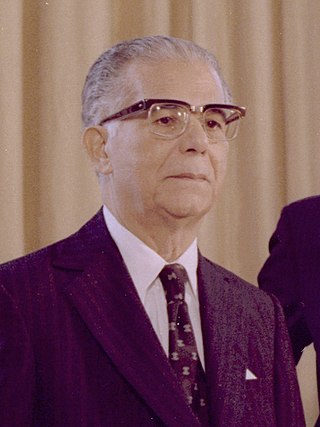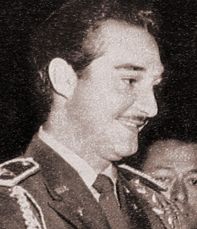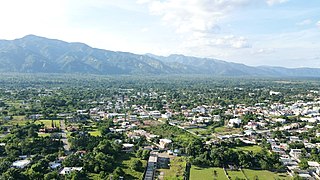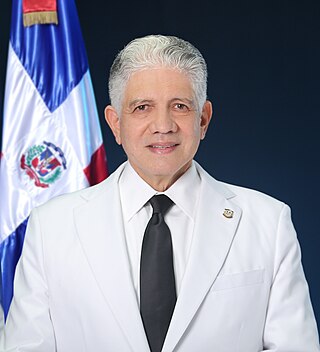Related Research Articles

The recorded history of the Dominican Republic began in 1492 when the Genoa-born navigator Christopher Columbus, working for the Crown of Castile, happened upon a large island in the region of the western Atlantic Ocean that later came to be known as the Caribbean. It was inhabited by the Taíno, an Arawakan people, who called the eastern part of the island Quisqueya (Kiskeya), meaning "mother of all lands." Columbus promptly claimed the island for the Spanish Crown, naming it La Isla Española, later Latinized to Hispaniola. After 25 years of Spanish occupation, the Taíno population in the Spanish-dominated parts of the island drastically decreased through genocide. With fewer than 50,000 remaining, the survivors intermixed with Spaniards, Africans, and others, forming the present-day tripartite Dominican population. What would become the Dominican Republic was the Spanish Captaincy General of Santo Domingo until 1821, except for a time as a French colony from 1795 to 1809. It was then part of a unified Hispaniola with Haiti from 1822 until 1844. In 1844, Dominican independence was proclaimed and the republic, which was often known as Santo Domingo until the early 20th century, maintained its independence except for a short Spanish occupation from 1861 to 1865 and occupation by the United States from 1916 to 1924.

Joaquín Antonio Balaguer Ricardo was a Dominican politician, scholar, writer, and lawyer. He was President of the Dominican Republic serving three non-consecutive terms for that office from 1960 to 1962, 1966 to 1978, and 1986 to 1996.

Rafael Leónidas Trujillo Molina, nicknamed El Jefe, was a Dominican military commander and dictator who ruled the Dominican Republic from August 1930 until his assassination in May 1961. He served as president from 1930 to 1938 and again from 1942 to 1952, ruling for the rest of his life as an unelected military strongman under figurehead presidents. His rule of 31 years, known to Dominicans as the Trujillo Era, is considered one of the bloodiest and most corrupt regimes in the Western hemisphere, and centered around a personality cult of the ruling family. Trujillo's security forces, including the infamous SIM, were responsible for perhaps as many as 50,000 murders, including between 12,000 and 30,000 Haitians in the infamous Parsley massacre in 1937, which continues to affect Dominican-Haitian relations to this day.

The Mirabal sisters were four sisters from the Dominican Republic, three of whom opposed the dictatorship of Rafael Trujillo and were involved in clandestine activities against his regime. The three sisters were assassinated on 25 November 1960. The last sister, Adela, who was not involved in political activities at the time, died of natural causes on 1 February 2014.
Aeromar Líneas Aéreas Dominicanas was an airline based in the Dominican Republic.
Col. Francisco Alberto Caamaño Deñó was a Dominican soldier and politician who took the constitutional presidency of the Dominican Republic during the Civil War of 1965. During the war, which began on April 24, 1965, Caamaño was one of the leaders in the movement to restore the democratically elected President Dr. Juan Bosch, who had been overthrown in a military coup d'état in September 1963.
Johnny Abbes García was the chief of the governmental intelligence office – the Servicio de Inteligencia Militar – during the dictatorship of Rafael Trujillo in the Dominican Republic. He ruled under Trujillo during the end of the Third Republic, and later served the Duvalier dynasty in Haiti.

José Salvador Omar Jorge Blanco was a politician, lawyer and a writer. He was President of the Dominican Republic, from 1982 to 1986. He was a Senator running for the PRD party. He started his political career as a Committee Secretary for the Unión Cívica de Santiago in 1963 and joined the PRD in 1964.

Rafael Leónidas Trujillo Martínez, better known as Ramfis Trujillo Martínez, was the son of Rafael Leónidas Trujillo, dictator of the Dominican Republic, after whose 1961 assassination he briefly held power. Nominally an army general, he lived the life of a reckless and spoiled playboy like his friend and sometime brother-in-law Porfirio Rubirosa. Remembered for his ruthlessness and cruelty, he went into exile in Spain, where he died after crashing a sports car.

Bonao is a city in the Cibao region of Dominican Republic. It is the capital of the Monseñor Nouel province. The city is located in the center of the country, to the northwest of the national capital Santo Domingo.

Rafael Filiberto Bonnelly Fondeur was a lawyer, scholar, diplomat, and, from 1962 until 1963, the President of the Dominican Republic. Before he became president, he was vice president of the country from 1960 to 1962.
Major General Antonio Cosme Imbert Barrera was a Dominican military general of the Dominican Army and was President of the Dominican Republic from May to August 1965.
Orlando Martínez Howley was a left-wing journalist and member of the Communist Party of the Dominican Republic who was a critic of President Joaquín Balaguer. He was ordered to be killed by the then president in 1975, and in 2000, four men were given 30-year jail sentences in connection with the killing. Orlando Martínez has become a symbol of freedom of expression in the Dominican Republic.

Rafael Eduardo Estrella Virella is a civil engineer and Dominican politician, current senator and president of the Senate since 2020. He served as Minister of State for Public Works and Communications of the Dominican Republic during the second term 1991–94, of President Joaquín Balaguer and also he served as Senator for the province of Santiago de los Caballeros during the period 1994–98.
María de los Ángeles del Sagrado Corazón de Jesús Trujillo Martínez, known as Angelita Trujillo, was a Dominican writer. She is most known by her role as the predilect daughter of former Dominican dictator Rafael Trujillo.

Rahintel was the first privately owned television network in the Dominican Republic and the second such network to start television broadcasts in the DR after La Voz Dominicana. It was owned and operated by Grupo Financiero Universal until the latter's bankruptcy in the late-1980s and was headquartered in Santo Domingo.
Aída Mercedes Batlle Morell de Bonnelly was a Dominican public figure and wife of former President Rafael Filiberto Bonnelly. She served as the First Lady of the Dominican Republic from January 18, 1962, to February 27, 1963. Battle was the great-granddaughter of Ulises Francisco Espaillat, another former Dominican president.
References
- ↑ "Conmemoran salida familia Trujillo del pais". Diario al Instante. 20 November 2016.
- ↑ Federico Marcos Didiez. "Hace 52 años: la rebelión de los pilotos".
- ↑ Museo Memorial de la Resistencia Dominicana. "Heroes del 30 de Mayo. Resenas Biograficas" (in Spanish). Retrieved 16 August 2012.
- ↑ Diederich, Bernard (1978). Trujillo, The Death of the Goat. Little, Brown, and Co. pp. 235ff. ISBN 978-0316184403.
- 1 2 Miguel Guerrero. "Los últimos días de Trujillo II: La conspiracion de los coroneles".
- ↑ Miguel Guerrero. "Los últimos días de Trujillo III: Un ataque con bombas y cohetes".
- ↑ Lajara Sola, Homero Luis (19 November 2016). "Los Pilotos de la Patria". Listin Diario.
- ↑ Hibrain Sosa, Naya Despradel (8 December 2012). "El Complot de los Pilotos- 19 de Noviembre 1961". El Caribe. Seccion Fin de Semana. pp. 6–7.
- ↑ Rivas, Ubi (19 March 2016). "Relata Brevario Avatares de Vida". El Nacional.